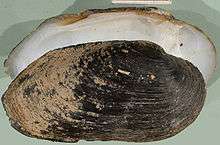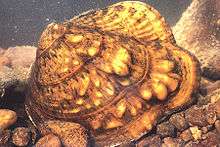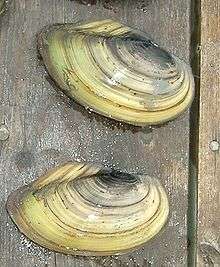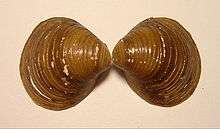Freshwater bivalve
Freshwater bivalves are one kind of freshwater molluscs, along with freshwater snails. They are bivalves which live in freshwater, as opposed to saltwater, the main habitat type for bivalves.
The majority of species of bivalve molluscs live in the sea, but in addition, a number of different families live in freshwater (and in some cases also in brackish water). These families belong to two different evolutionary lineages (freshwater mussels and freshwater clams), and the two groups are not closely related.
Freshwater bivalves live in many types of habitat, ranging from small ditches and ponds, to lakes, canals, rivers, and swamps.
Species in the two groups vary greatly in size. Some of the pea clams (Pisidium species) have an adult size of only 3 mm. In contrast, one of the largest species of freshwater bivalves is the swan mussel, in the family Unionidae; it can grow to a length of 20 cm, and usually lives in lakes or slow rivers.
Freshwater pearl mussels are economically important as a source of freshwater pearls and mother of pearl.
Taxonomy
Order Unionida
The Unionida, of worldwide distribution, are the pearly freshwater mussels. All reproduce by means of a larval stage that is parasitic on a fish or salamander. Many species are utilized as sources of mother-of-pearl.
Families:
- Order Unionida: pearly freshwater mussels
 Family Margaritiferidae, a shell of Margaritifera auricularia
Family Margaritiferidae, a shell of Margaritifera auricularia Family Unionidae, Quadrula metanevra, the monkeyface mussel
Family Unionidae, Quadrula metanevra, the monkeyface mussel Family Unionidae, Anodonta cygnea
Family Unionidae, Anodonta cygnea
Order Veneroida
The Veneroida is a large group of bivalve "clams", most of which are marine. However, several families occur in fresh and brackish waters.
Families:
- Order Veneroida
 Family Corbiculidae, shell of Corbicula fluminea
Family Corbiculidae, shell of Corbicula fluminea Family Sphaeriidae, Sphaerium corneum, one of the small fingernail clams.
Family Sphaeriidae, Sphaerium corneum, one of the small fingernail clams. Family Dreissenidae, Dreissena polymorpha
Family Dreissenidae, Dreissena polymorpha